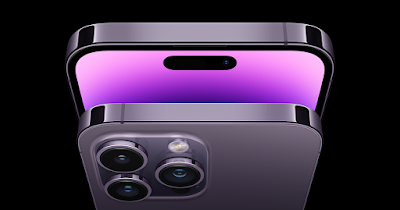(Credit : Apple)
iPhone 14 Pro Giving a Good User Experience | iPhone 14 Pro
What makes a big phone in 2022? This has been a moving goal for a number of years, although it is one that is steadily moving in one direction. It's hard to pinpoint the exact average display size, but most flagship smartphone screens typically fall between six and seven inches.
In 2010, Steve Jobs touted four inches as the ideal screen size. "You can't believe it," he remarked as Android phones slowly grew. "No one will buy it." The following year, Samsung released the first Galaxy Note. The 5.3-inch screen caused some disgust. The first notable phablet was simply too big for pockets and hands.
The following decade made those comments strange. Technology has a way to do it. Fast forward to 2022 and the four new versions of the iPhone 14 come in two sizes: 6.1 and 6.7 inches. A lot has happened to bring us here, not the least of which is a noticeable increase in screen to body ratio. As screens got bigger, the overall footprint needed to support them got smaller.
I've been using the regular iPhone 14 as my primary device for the past few weeks. I can't wrap it completely with my hand, but close enough. Most importantly, it is easy to use with one hand. We've come a long way since the days when a 5.3-inch phone looked almost incredibly big.
For my daily use, I have really come to appreciate 6.1 inches as a sweet spot. It's a good-sized screen with a hardware footprint that's not overwhelming. As always, your mileage may vary. Some people were understandably disappointed when the iPhone 14 line actually marked the death of the Mini. Wanting a smaller phone is perfectly reasonable and the SE will have to fill that role for now.
As you will surely have guessed by reading this, I have since moved to the 14 Plus for everyday use. I'll say right away that I can't really wrap my hand around it. Using it in one hand is a bit more of a mixed bag. With face unlock enabled, there are a few actions that is perfectly possible to perform like this: checking emails, scrolling through the fate of social media - basically the things most of us do on our phones most of the time.
On the other hand, if you want to reply to an email for example, things get complicated. I can usually contort myself to select the specific message, but hitting replay in Gmail and typing takes both hands. If you're deep in the world of voice computers, you might have a workaround that works for you.
As with all things in life, there is a trade-off here. I like the 6.7 inch size for things like video. It's also nice to have that whole screen as a viewfinder while taking photos. I moderated a panel at a Brooklyn bookstore earlier this week, and it's large in size to serve as a kind of makeshift teleprompter. Sure, that's a pretty niche need, but when you go from 6.1 to 6.7 inches, these kinds of benefits start to manifest pretty quickly.
Screen size aside, the biggest advantage of opting for the Plus over the standard 14 is the battery. The Plus is rated for 26 hours of video playback compared to the 14's 20 hours. In practice, for me, that meant going to bed with around 50% battery and waking up with around 37%.
You should be able to go through a full 24 hours without any issues. It's a nice peace of mind not having to worry about finding a charger during the day. We're not talking about a leap from Apple Watch Series 8 to Ultra-size here, but there's a lot to be said for not worrying about your phone dying when you're out in the world.
The 14 Plus sits on an interesting frontier of the iPhone lineup. This is the entry level model and not the top of the range. It's closer to the old one and similar in virtually every way except size. Interestingly, it's actually lighter than the smaller 14 Pro. This is something I noticed almost immediately after using the Pro for a bit too. That's certainly remarkable for a big phone like this. At $899, it's also $100 cheaper than the Pro and $200 cheaper than the Pro Max.
The 14 is the go-to device when you want a new iPhone but don't need all the latest bells and whistles. The 14 Pro is at the cutting edge of iPhone technology. The 14 Pro Max is a kitchen sink appliance. The Plus is for the person who prefers the larger screen but doesn't need all the aforementioned frills. The surefire way to find out which one is right for you is to tailor them with a local brick and mortar.
I would say the standard 14 makes the most sense for most users. Upgrade to Pro if you want better photos and a faster chip (and/or are generally blindsided by everything Dynamic Island has to offer). However, if screen size is your main concern, 0.6 inches makes a big difference.


















No comments:
Write comments